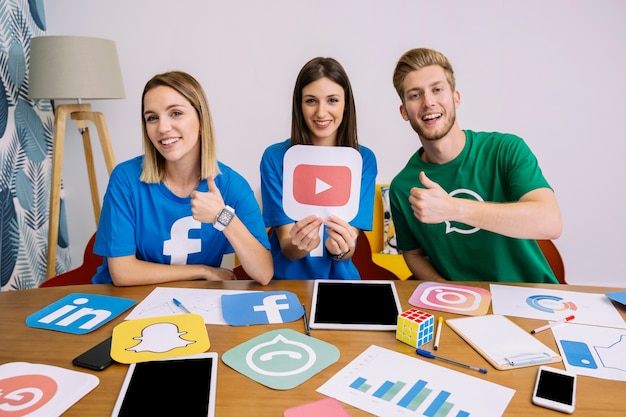Social Media Influencer Marketing: The Ultimate Guide to Building Powerful Brand Connections

Introduction to Social Media Influencer Marketing
Social media influencer marketing is one of the most effective and dynamic strategies in the modern marketing world. With the rise of social media platforms like Instagram, YouTube, TikTok, Facebook, and Twitter, the way brands communicate with their audience has transformed dramatically. Instead of relying solely on traditional advertising, companies now collaborate with influencers—individuals who have built dedicated followings on these platforms. These influencers act as trusted voices who can authentically promote products and services to their audiences. Unlike celebrity endorsements of the past, influencer marketing feels personal, relatable, and genuine, making it highly effective in driving engagement and conversions.
What Is Social Media Influencer Marketing?
Social media influencer marketing is a strategy where brands partner with individuals who have influence over specific audiences on social media platforms. Influencers can be celebrities, industry experts, content creators, or even regular people who have cultivated loyal followers around a niche interest. They create and share content featuring a brand’s products or services, which drives awareness, credibility, and sales. The authenticity of influencer recommendations is often what makes them so effective. Followers see influencers as trusted peers, and their endorsements can carry far more weight than traditional advertising.
Types of Social Media Influencers
When designing an influencer marketing strategy, it’s essential to understand the different types of influencers:
Mega-Influencers: These are celebrities or social media stars with over a million followers. They have broad reach but can be expensive and less targeted.
Macro-Influencers: Influencers with 100,000 to 1 million followers. They maintain significant reach while offering better audience targeting than mega-influencers.
Micro-Influencers: Typically 10,000 to 100,000 followers. They often have highly engaged niche audiences and are seen as more relatable and authentic.
Nano-Influencers: Fewer than 10,000 followers. They usually have very high engagement rates and strong trust with their small, tight-knit communities.
Each influencer tier offers unique advantages depending on your brand goals, budget, and target audience.
Why Brands Use Influencer Marketing
Social media influencer marketing has become a cornerstone for brands because it delivers multiple benefits:
Authenticity: Influencers build trust with their audiences by sharing personal experiences and recommendations, making marketing messages feel more genuine.
Targeted Reach: Brands can choose influencers whose audiences align with their target customers, ensuring marketing efforts are focused and effective.
Higher Engagement: Influencer content often achieves better engagement rates than traditional ads because it feels less like advertising and more like a personal recommendation.
Improved ROI: Many brands find influencer campaigns deliver a higher return on investment than other marketing channels.
Content Creation: Influencers are skilled content creators who can produce high-quality photos, videos, and posts for brands to reuse.
Brand Awareness: Influencers can introduce your brand to new audiences in an organic, engaging way.
How Social Media Influencer Marketing Works
At its core, influencer marketing is about relationships. The process typically involves several steps:
Identifying Goals: What do you want to achieve? Goals can include boosting brand awareness, driving sales, increasing app downloads, or growing social media followers.
Finding the Right Influencers: Brands research and select influencers whose audience demographics, content style, and values align with their own.
Building Relationships: Influencer marketing isn’t just transactional. Successful partnerships often involve developing genuine, long-term relationships.
Defining Campaign Details: This includes deciding on deliverables (like posts, stories, videos), timelines, payment, and campaign guidelines.
Content Creation and Approval: Influencers create content, often collaborating with the brand to ensure messaging aligns with brand guidelines while retaining their authentic voice.
Publishing and Promotion: The influencer shares the content with their audience. Brands may also repurpose this content on their own channels.
Measuring Results: Brands track key performance indicators (KPIs) such as reach, engagement, website traffic, and sales conversions to evaluate campaign success.
Popular Social Media Platforms for Influencer Marketing
Different platforms suit different types of influencer campaigns.
Instagram: Highly visual, popular for lifestyle, fashion, beauty, travel, and food brands. Stories, Reels, and posts offer multiple content formats.
YouTube: Ideal for in-depth reviews, tutorials, and storytelling. Videos have high engagement and SEO value.
TikTok: Short-form, viral-friendly content appeals to younger audiences. Creative challenges and trends drive massive reach.
Facebook: Still valuable for certain demographics, especially for community groups and longer-form posts.
Twitter: Best for real-time conversations, news, and niche communities. Influencer tweets can drive traffic and discussion.
LinkedIn: B2B influencer marketing thrives here, with thought leadership posts and industry discussions.
How to Choose the Right Influencers for Your Brand
Choosing the right influencers is one of the most critical aspects of your campaign. Consider these factors:
Audience Demographics: Ensure the influencer’s followers match your target customers in age, location, interests, and buying habits.
Engagement Rate: A smaller audience with high engagement is often more valuable than a massive following with little interaction.
Content Quality and Style: Does their content align with your brand’s voice and aesthetic?
Authenticity and Trust: Followers can spot fake endorsements. Choose influencers who genuinely like and use your products.
Previous Partnerships: Review their past brand collaborations to ensure there are no conflicts or over-saturation.
Platform Fit: Make sure the influencer is strong on the platform that matters most to your audience.
Creating an Effective Influencer Marketing Strategy
A successful influencer marketing strategy requires careful planning.
Define Your Goals: Be specific. For example, aim for a 10% increase in sales, 5,000 new Instagram followers, or 50,000 website visits.
Set Your Budget: Influencer rates vary widely. Plan for payment, product seeding, and potential ad amplification.
Research and Vet Influencers: Use tools like BuzzSumo, Upfluence, or AspireIQ to find and evaluate influencers.
Outreach and Negotiation: Approach influencers professionally. Discuss expectations, deliverables, timelines, and compensation.
Campaign Brief: Provide clear guidelines while allowing creative freedom. Influencers know what resonates with their audience.
Track and Measure Results: Use tracking links, discount codes, and platform analytics to measure ROI.
Measuring the Success of Influencer Campaigns
It’s essential to measure your influencer marketing efforts to understand what’s working and refine your strategy.
Reach: How many people saw the influencer’s content?
Engagement: Likes, comments, shares, and saves indicate audience interest.
Traffic: Did the campaign drive visitors to your website or app?
Conversions: How many sales or signups can be attributed to the campaign?
Brand Sentiment: Monitor conversations and feedback to see how people feel about your brand.
Content Value: Assess the quality of the content created for future use.
Common Challenges in Influencer Marketing
While effective, influencer marketing isn’t without challenges.
Fake Followers: Some influencers inflate their follower counts with bots. Brands must vet influencers carefully.
Low Engagement: Even real followers may not engage if the content isn’t compelling or if the influencer posts too many ads.
Brand Safety: Brands need to ensure influencers’ content aligns with their values to avoid reputational risks.
Creative Control vs. Authenticity: Overly controlling brands can stifle authenticity, reducing effectiveness.
Measuring ROI: Attributing sales to influencer campaigns can be complex.
Trends Shaping the Future of Influencer Marketing
Influencer marketing continues to evolve rapidly.
Shift to Micro- and Nano-Influencers: Brands increasingly value smaller influencers with high engagement and authenticity.
Video Dominance: Short-form videos on TikTok, Instagram Reels, and YouTube Shorts are leading the way.
Long-Term Partnerships: Brands are moving away from one-off posts to long-term ambassador programs.
Performance-Based Payment: Influencers increasingly paid based on results (e.g., sales, signups).
AI and Virtual Influencers: Computer-generated influencers like Lil Miquela are gaining popularity.
E-Commerce Integration: Social shopping features on Instagram and TikTok allow influencers to sell products directly.
Greater Regulation: Governments are enforcing disclosure rules to maintain transparency.
Best Practices for Successful Influencer Campaigns
To make your campaigns effective, follow these best practices:
Prioritize Authenticity: Choose influencers who genuinely like your products.
Build Relationships: Treat influencers as partners, not just marketing channels.
Give Creative Freedom: Influencers know what resonates with their audience.
Set Clear Expectations: Define deliverables, timelines, and payment terms in writing.
Diversify Influencer Tiers: Combine mega, macro, micro, and nano influencers for balanced reach and engagement.
Leverage User-Generated Content: Reuse influencer content across your marketing channels.
Monitor and Adapt: Continuously measure performance and refine your approach.
Case Studies of Successful Influencer Marketing Campaigns
Daniel Wellington: Built an entire brand by gifting watches to thousands of micro-influencers who posted stylish photos.
Gymshark: Created a community of fitness influencers who acted as brand ambassadors, driving massive organic growth.
Glossier: Encouraged everyday users to share their makeup looks, turning customers into influencers.
Airbnb: Partnered with travel influencers to showcase unique stays around the world, boosting bookings.
These case studies show that with the right strategy, influencer marketing can drive real business results.
The Role of Agencies and Platforms in Influencer Marketing
Many brands work with influencer marketing agencies or platforms to streamline the process.
Agencies: Offer end-to-end services, from influencer discovery and negotiation to campaign management and reporting.
Platforms: Self-service tools like CreatorIQ, AspireIQ, and Traackr help brands find, vet, and manage influencers at scale.
These partners can save time, reduce risk, and improve campaign outcomes.
Conclusion: Embrace the Power of Influencer Marketing
Social media influencer marketing isn’t a passing trend—it’s a powerful, proven strategy that enables brands to connect with audiences in authentic, engaging ways. By partnering with the right influencers, brands can expand their reach, build trust, and drive meaningful results. However, success requires more than paying for a post. It demands careful planning, strategic alignment, and genuine collaboration. As social media continues to evolve, influencer marketing will only become more sophisticated and essential. Brands that learn to harness its power thoughtfully and authentically will be well-positioned to thrive in an increasingly digital world.



